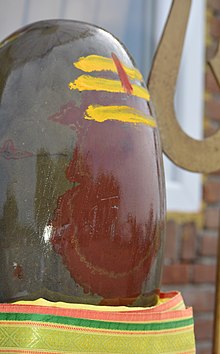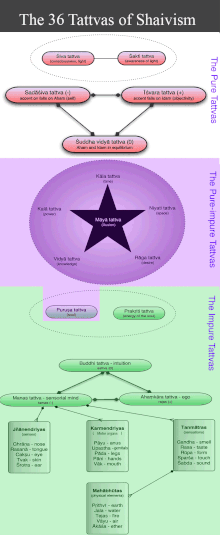Parashiva

| Part ofa serieson |
| Shaivism |
|---|
 |
|
|
Parashiva(orParamashiva,Paramshiva,orParmshiva,among other spellings;Sanskrit:परशिव,IAST:Paraśiva)[1]is the highest aspect of Shiva inShaiva Siddhantaand inKashmir Shaivism.Below him are the primordial Shiva with the Parashakti and Sadashiva with seven Shaktis.
Shaiva Siddhanta[edit]
According to the Shaiva Siddhanta tradition, which is a major school ofShaivism,Parashiva is absolute reality which is beyond human comprehension and is beyond all attributes. According toMahamahopadhaya Gopinath Kaviraj,in this aspectShivais both formless and with forms. He is beyond both dvaita and advaita.[2][3]In Shaivite theology, Parashiva is both the source and the destination of everything in the existence.
According to theShaiva Siddhantatradition, the other two aspects ofShivaareParashaktiandParameshwara.[4][5][6]
The upper part (oval stone) ofShiva Lingamrepresents Parashiva while lower part (pedestal) representsParashakti.[7]Parashiva is beyond all of the36 tattvasmentioned inShaivismphilosophy.[8]
Kashmir Shaivism[edit]

Kashmiri Shaivism describes how all of reality, with all of its diversity and fluctuation, is the play of the single principle, Paramashiva. The two aspects of this single reality are inseparably united: Shiva and Shakti.[9]Paramashivaappearsas the world through his creative power, Shakti. The ontological nature of Paramashiva is beyond human knowledge and articulation, yet it can be experienced directly through mystical intuition.[10]
The Kashmir Shaivism tradition, also called Trika Shaivism, is anon-dualistbranch ofShaiva-ShaktaTantraHinduismthat originated inKashmirafter 850 CE.[11][12]In its place of origin in Kashmir, this tradition is commonly referred to as "Kashmiri Shaivism."It later spread beyond Kashmir, with its great scholarAbhinavaguptacalling it "Trika" (meaning "the Trinity" ). It particularly flourished in the states ofOdishaandMaharashtra.[12][13]Defining features of the Trika tradition are itsidealisticandmonisticPratyabhijna( "Recognition" ) philosophical system, propounded byUtpaladeva(c. 925–975 CE) and Abhinavagupta (c. 975–1025 CE), and the centrality of the three goddessesParā,Parāparā, and Aparā.[11][12]
This sectionneeds expansion.You can help byadding to it.(October 2023) |
See also[edit]
References[edit]
- ^"Glossary".search for "Paraśiva".
- ^Dancing with Siva.pp. ŚLOKA 16 (What Is the Nature of Our God Śiva?).
- ^Dancing with Siva.ŚLOKA 17(https://www.himalayanacademy.com/media/books/dancing-with-siva/web/ch02_02.html).
- ^"Parashakti".
- ^"Parameshwara".
- ^Dancing with Siva.Himalayan Academy. 30 June 2003. search 'परमेश्वर ' and 'पराशक्ति '.ISBN0945497946.
- ^"Hinduism for Children".Search for "Śivaliṅga".
- ^"36 tattva".
- ^Edward Quinn (2014).Critical Companion to George Orwell.Infobase Publishing. p. 229.ISBN9781438108735.
- ^Jagadish Chandra Chatterji (1914).Kashmir Shaivaism.SUNY Press. pp. viii.ISBN9780887061790.
- ^abDavid Peter Lawrence,Kashmiri Shaiva Philosophy,Internet Encyclopedia of Philosophy
- ^abcWallis, Christopher; Tantra Illuminated, chapter II, The History of Śaiva Tantra
- ^Carl Olson,The Many Colors of Hinduism,Rutgers University Press, 2007, page 237

